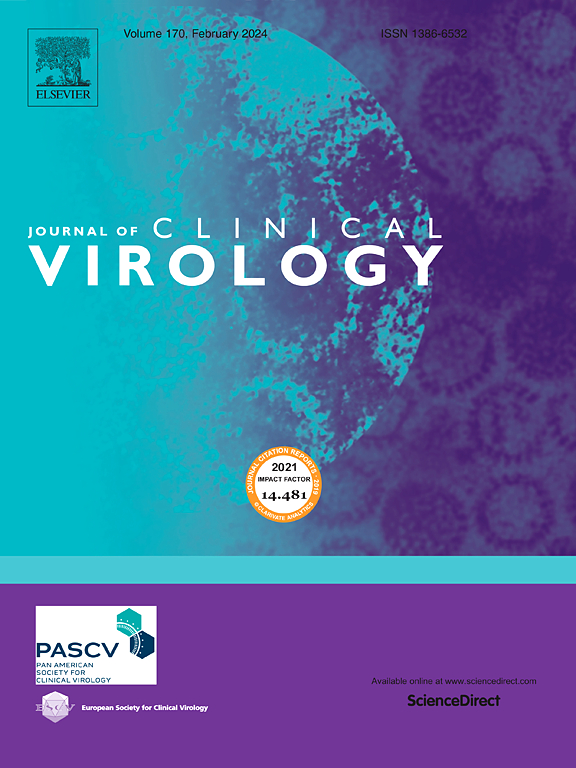快速多重聚合酶链反应对诊断为病毒性脑膜炎儿童住院时间和抗菌药物使用的影响
IF 3.4
3区 医学
Q2 VIROLOGY
引用次数: 0
摘要
脑膜炎和脑炎可导致严重的发病率,并导致儿童永久性的神经功能缺损,但结果因致病病原体而异。病毒性脑膜炎的早期诊断可能允许适当的管理,包括避免抗微生物治疗和住院。我们试图确定在一家四级护理儿科机构诊断为人类肠病毒(HEV)和人类parechovirus (HPeV)脑膜炎的患者中多重脑膜炎-脑炎(ME)小组的临床应用。回顾性分析了2016年6月至2023年10月期间由ME小组诊断的HEV或HPeV阳性患者(n = 66)与2011年12月至2016年5月期间通过独立PCR(聚合酶链反应)诊断的HEV或HPeV阳性患者(n = 53)。ME面板的周转时间(TAT)为2.67 h,而独立聚合酶链反应(PCR)的周转时间为22.05 h (p <; 0.0001)。与单独PCR相比,在入院72 h内收集脑脊液(CSF)并进行ME panel检测的患者,静脉注射阿昔洛韦的持续时间显著缩短(3.88 vs 16.03 h, P = 0.03)。尽管采用分子方法检测病毒,但患者仍继续使用抗生素,直到培养48 h后确认脑脊液培养为阴性。在儿科医院实施ME面板提高了病毒性(或无菌性)ME诊断的总体时间。虽然没有统计学意义,但与独立PCR相比,mepanel检测出HEV或HPeV阳性的患者的中位住院时间(LOS)减少了0.51天(1.95天对2.46天,p = 0.66)。本文章由计算机程序翻译,如有差异,请以英文原文为准。
Impact on hospital length of stay and antimicrobial usage in children diagnosed with viral meningitis by rapid multiplexed PCR assay
Meningitis and encephalitis can lead to severe morbidity and result in permanent neurologic deficits in children, but outcomes differ depending on the causative pathogen. Early diagnosis of viral meningitis may allow for appropriate management, including avoidance of antimicrobial treatment and hospital admission. We sought to determine the clinical utility of a multiplexed meningitis-encephalitis (ME) panel at a quaternary care pediatric institution in patients diagnosed with human enterovirus (HEV) and human parechovirus (HPeV) meningitis. Retrospective analysis of patients between June 2016 and October 2023 positive for HEV or HPeV (n = 66) by ME panel were compared to HEV or HPeV positive patients (n = 53) diagnosed by standalone PCR (polymerase chain reaction) between December 2011 and May 2016. The turnaround time (TAT) for ME panel was 2.67 h compared to 22.05 h for standalone polymerase chain reaction (PCR) (p < 0.0001). In patients with cerebrospinal fluid (CSF) collected and tested by ME panel within 72 h of admission compared to standalone PCR, the duration of intravenous acyclovir therapy was significantly reduced (3.88 vs 16.03 h, P = 0.03). Despite viral detection by molecular methods, patients remained on antibiotics until CSF cultures were confirmed to be negative after 48 h of incubation. Implementation of ME panel in a pediatric hospital improved overall time to diagnosis of viral (or aseptic) ME. Although not statistically significant, the median length of stay (LOS) of patients positive for HEV or HPeV by ME panel was reduced by 0.51 days when compared to standalone PCR (1.95 vs. 2.46 days, p = 0.66).
求助全文
通过发布文献求助,成功后即可免费获取论文全文。
去求助
来源期刊

Journal of Clinical Virology
医学-病毒学
CiteScore
22.70
自引率
1.10%
发文量
149
审稿时长
24 days
期刊介绍:
The Journal of Clinical Virology, an esteemed international publication, serves as the official journal for both the Pan American Society for Clinical Virology and The European Society for Clinical Virology. Dedicated to advancing the understanding of human virology in clinical settings, the Journal of Clinical Virology focuses on disseminating research papers and reviews pertaining to the clinical aspects of virology. Its scope encompasses articles discussing diagnostic methodologies and virus-induced clinical conditions, with an emphasis on practicality and relevance to clinical practice.
The journal publishes on topics that include:
• new diagnostic technologies
• nucleic acid amplification and serologic testing
• targeted and metagenomic next-generation sequencing
• emerging pandemic viral threats
• respiratory viruses
• transplant viruses
• chronic viral infections
• cancer-associated viruses
• gastrointestinal viruses
• central nervous system viruses
• one health (excludes animal health)
 求助内容:
求助内容: 应助结果提醒方式:
应助结果提醒方式:


